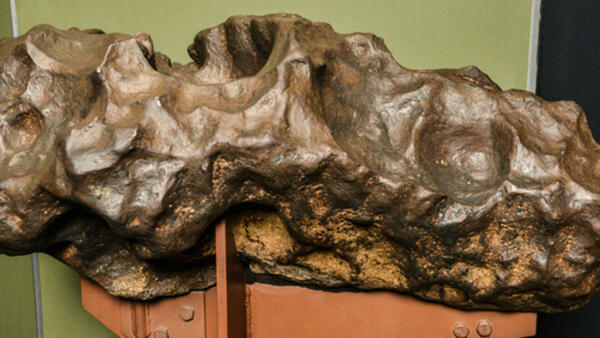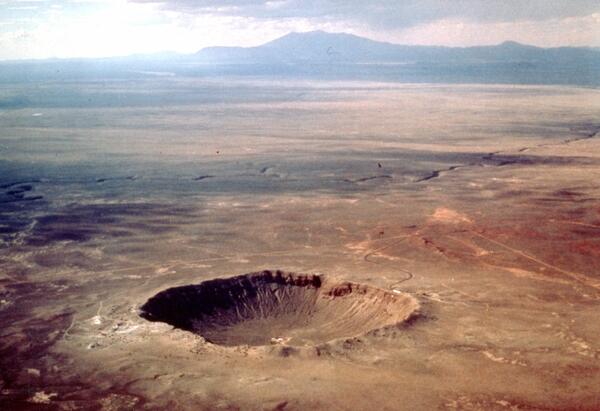A 200-kilogram (440-pound) fragment of the Canyon Diablo meteorite that was found at Meteor Crater in Arizona
linkA 200-kilogram (440-pound) fragment of the Canyon Diablo meteorite that was found at Meteor Crater in Arizona.

An official website of the United States government
Here's how you know
Official websites use .gov
A .gov website belongs to an official government organization in the United States.
Secure .gov websites use HTTPS
A lock () or https:// means you’ve safely connected to the .gov website. Share sensitive information only on official, secure websites.
Meteorites are fragments of rock or metal that fall to Earth from space. They are very rare, but many people find unusual rocks or pieces of metal and wonder if they might have found a meteorite. The USGS doesn't verify meteorites, but they have several properties that help distinguish them from other rocks:
Meteorites do NOT have the following:
These tips for identifying a meteorite were adapted from a guide by the University of New Mexico Meteorite Museum.
Rocks and minerals--including potential meteorites--must be examined in person for proper identification. For suggestions on where to do that, see: Can you identify my rock or mineral?

A 200-kilogram (440-pound) fragment of the Canyon Diablo meteorite that was found at Meteor Crater in Arizona.
A 200-kilogram (440-pound) fragment of the Canyon Diablo meteorite that was found at Meteor Crater in Arizona.

Aerial view of Arizona's Meteor Crater, a 180 meter deep, 1.2 kilometer diameter bowl-shaped impact crater in Northern Arizona. The crater formed approximately 50,000 years ago by the impact of a 100,000-ton iron-nickel meteorite that was approximately 30 meters in diameter and struck at an approximate speed of 12-20 km/sec.
Aerial view of Arizona's Meteor Crater, a 180 meter deep, 1.2 kilometer diameter bowl-shaped impact crater in Northern Arizona. The crater formed approximately 50,000 years ago by the impact of a 100,000-ton iron-nickel meteorite that was approximately 30 meters in diameter and struck at an approximate speed of 12-20 km/sec.

Meteor Crater formed approximately 50,000 years ago by the impact of a 100,000-ton iron-nickel meteorite, ~30 m in diameter, which struck at an approximate speed of 12-20 km/sec.
Meteor Crater formed approximately 50,000 years ago by the impact of a 100,000-ton iron-nickel meteorite, ~30 m in diameter, which struck at an approximate speed of 12-20 km/sec.

A 200-kilogram (440-pound) fragment of the Canyon Diablo meteorite that was found at Meteor Crater in Arizona.
A 200-kilogram (440-pound) fragment of the Canyon Diablo meteorite that was found at Meteor Crater in Arizona.

Aerial view of Arizona's Meteor Crater, a 180 meter deep, 1.2 kilometer diameter bowl-shaped impact crater in Northern Arizona. The crater formed approximately 50,000 years ago by the impact of a 100,000-ton iron-nickel meteorite that was approximately 30 meters in diameter and struck at an approximate speed of 12-20 km/sec.
Aerial view of Arizona's Meteor Crater, a 180 meter deep, 1.2 kilometer diameter bowl-shaped impact crater in Northern Arizona. The crater formed approximately 50,000 years ago by the impact of a 100,000-ton iron-nickel meteorite that was approximately 30 meters in diameter and struck at an approximate speed of 12-20 km/sec.

Meteor Crater formed approximately 50,000 years ago by the impact of a 100,000-ton iron-nickel meteorite, ~30 m in diameter, which struck at an approximate speed of 12-20 km/sec.
Meteor Crater formed approximately 50,000 years ago by the impact of a 100,000-ton iron-nickel meteorite, ~30 m in diameter, which struck at an approximate speed of 12-20 km/sec.
